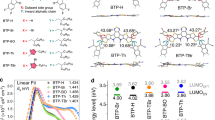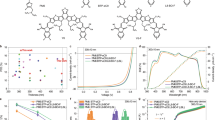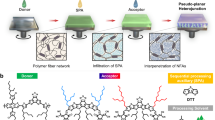Abstract
Printing of large-area solar panels necessitates advanced organic solar cells with thick active layers. However, increasing the active layer thickness typically leads to a marked drop in the power conversion efficiency. Here we developed an organic semiconductor regulator, called AT-β2O, to tune the crystallization sequence of the components in active layers. When adding AT-β2O in the donor (D18-Cl) and acceptor (N3) blend, N3 crystallizes behind D18-Cl, and this phenomenon is different from the co-crystallization observed in binary D18-Cl:N3 blends. This manipulation of crystallization dynamics is favourable to form bulk-heterojunction-gradient vertical phase separation in the active layer accompanied by the high crystallinity of the acceptor and balanced charge carrier mobilities in thick films. The resultant single-junction organic solar cells exhibited a certified power conversion efficiency of over 20%, as well as demonstrated exceptional adaptability across the active layer thicknesses (100–400 nm) and remarkable universality. Such breakthroughs enable large-area modules with a certified power conversion efficiency of 18.04%.
This is a preview of subscription content, access via your institution
Access options
Access Nature and 54 other Nature Portfolio journals
Get Nature+, our best-value online-access subscription
27,99 € / 30 days
cancel any time
Subscribe to this journal
Receive 12 print issues and online access
269,00 € per year
only 22,42 € per issue
Buy this article
- Purchase on SpringerLink
- Instant access to full article PDF
Prices may be subject to local taxes which are calculated during checkout






Similar content being viewed by others
Data availability
The experimental data that support the findings of this paper are available within the Article and its Supplementary Information. The other findings of this study are available from the corresponding author upon reasonable request. Source data are provided with this paper.
Code availability
The codes used to analyse the data in this study are available from the corresponding author upon reasonable request.
References
Lin, Y. et al. An electron acceptor challenging fullerenes for efficient polymer solar cells. Adv. Mater. 27, 1170–1174 (2015).
Hou, J. et al. Organic solar cells based on non-fullerene acceptors. Nat. Mater. 17, 119–128 (2018).
Chen, H. et al. Central unit fluorination of non-fullerene acceptor enables highly efficient organic solar cells with over 18% efficiency. Angew. Chem. Int. Ed. 61, e202209580 (2022).
Yuan, J. et al. Single-junction organic solar cell with over 15% efficiency using fused-ring acceptor with electron-deficient core. Joule 3, 1140–1151 (2019).
Liu, Y. et al. Recent progress in organic solar cells (part II device engineering). Sci. China Chem. 65, 1457–1497 (2022).
Sun, R. et al. High-speed sequential deposition of photoactive layers for organic solar cell manufacturing. Nat. Energy 7, 1087–1099 (2022).
Liu, Y. et al. Recent progress in organic solar cells (part I material science). Sci. China Chem. 65, 224–268 (2022).
Xu, T. et al. High-performance organic solar cells containing pyrido[2,3-b]quinoxaline-core-based small-molecule acceptors with optimized orbit overlap lengths and molecular packing. Angew. Chem. Int. Ed. 62, e202304127 (2023).
Li, C. et al. Non-fullerene acceptors with branched side chains and improved molecular packing to exceed 18% efficiency in organic solar cells. Nat. Energy 6, 605–613 (2021).
Zhu, L. et al. Single-junction organic solar cells with over 19% efficiency enabled by a refined double-fibril network morphology. Nat. Mater. 21, 656–663 (2022).
Zuo, L. et al. Dilution effect for highly efficient multiple-component organic solar cells. Nat. Nanotechnol. 17, 53–60 (2021).
Kong, X. et al. 18.55% efficiency polymer solar cells based on a small molecule acceptor with alkylthienyl outer side chains and a low-cost polymer donor PTQ10. CCS Chem. 5, 841–850 (2023).
Liu, S. et al. High-efficiency organic solar cells with low non-radiative recombination loss and low energetic disorder. Nat. Photon. 14, 300–305 (2020).
Fu, J. et al. Rational molecular and device design enables organic solar cells approaching 20% efficiency. Nat. Commun. 15, 1830 (2024).
Wang, J. et al. Binary organic solar cells with 19.2% efficiency enabled by solid additive. Adv. Mater. 35, 2301583 (2023).
Chen, H. et al. A guest-assisted molecular-organization approach for >17% efficiency organic solar cells using environmentally friendly solvents. Nat. Energy 6, 1045–1053 (2021).
Cai, Y. et al. Vertically optimized phase separation with improved exciton diffusion enables efficient organic solar cells with thick active layers. Nat. Commun. 13, 2369 (2022).
Camaioni, N. et al. Polymer solar cells with active layer thickness compatible with scalable fabrication processes: a meta-analysis. Adv. Mater. 35, 2210146 (2023).
Li, W. et al. Efficient small bandgap polymer solar cells with high fill factors for 300 nm thick films. Adv. Mater. 25, 3182–3186 (2013).
Chen, Z. et al. Low band-gap conjugated polymers with strong interchain aggregation and very high hole mobility towards highly efficient thick-film polymer solar cells. Adv. Mater. 26, 2586–2591 (2014).
Zhang, J. et al. Material insights and challenges for non-fullerene organic solar cells based on small molecular acceptors. Nat. Energy 3, 720–731 (2018).
Classen, A. et al. The role of exciton lifetime for charge generation in organic solar cells at negligible energy-level offsets. Nat. Energy 5, 711–719 (2020).
Firdaus, Y. et al. Long-range exciton diffusion in molecular non-fullerene acceptors. Nat. Commun. 11, 5220 (2020).
Li, Y. et al. Nanoscale heterogeneous distribution of surface energy at interlayers in organic bulk-heterojunction solar cells. Joule 5, 3154–3168 (2021).
Wang, J. et al. Regulating bulk-heterojunction molecular orientations through surface free energy control of hole-transporting layers for high-performance organic solar cells. Adv. Mater. 31, 1806921 (2019).
Mikhnenko, O. V. et al. Exciton diffusion in organic semiconductors. Energy Environ. Sci. 8, 1867–1888 (2015).
Zhang, G. et al. Overcoming space-charge effect for efficient thick-film non-fullerene organic solar cells. Adv. Energy Mater. 8, 1801609 (2018).
Wang, J. et al. Synergetic strategy for highly efficient and super flexible thick-film organic solar cells. Adv. Energy Mater. 12, 2201614 (2022).
Zou, B. et al. Step-by-step modulation of crystalline features and exciton kinetics for 19.2% efficiency ortho-xylene processed organic solar cells. Nano-Micro Lett. 16, 30 (2023).
Xu, X. et al. Sequential deposition of multicomponent bulk heterojunctions increases efficiency of organic solar cells. Adv. Mater. 35, 2208997 (2023).
Chen, S. et al. A polyfluoroalkyl-containing non-fullerene acceptor enables self-stratification in organic solar cells. Angew. Chem. Int. Ed. 62, e202213869 (2023).
Wan, J. et al. All-green solvent-processed planar heterojunction organic solar cells with outstanding power conversion efficiency of 16. Adv. Funct. Mater. 32, 2107567 (2022).
Zhang, H. et al. Sequentially processed bulk-heterojunction-buried structure for efficient organic solar cells with 500 nm thickness. Adv. Mater. 36, 2400521 (2024).
Zhu, L. et al. Efficient organic solar cell with 16.88% efficiency enabled by refined acceptor crystallization and morphology with improved charge transfer and transport properties. Adv. Energy Mater. 10, 1904234 (2020).
Wang, L. et al. Donor–acceptor mutually diluted heterojunctions for layer-by-layer fabrication of high-performance organic solar cells. Nat. Energy 9, 208–218 (2024).
Hua, B. et al. Pillar[5]arene-based solid-state supramolecular polymers with suppressed aggregation-caused quenching effects and two-photon excited emission. J. Am. Chem. Soc. 142, 16557–16561 (2020).
He, C. et al. Asymmetric electron acceptor enables highly luminescent organic solar cells with certified efficiency over 18%. Nat. Commun. 13, 2598 (2022).
Qiu, J. et al. Synergistic solvation effects: enhanced compound solubility using binary solvent mixtures. Org. Process Res. Dev. 23, 1343–1351 (2019).
Wang, X. et al. Synergistic effect of dual hydrogen-donor deep eutectic solvent for performance improvement of fracturing-oil expulsion fluids. Chem. Eng. J. 468, 143728 (2023).
Guo, X. et al. Polymer solar cells with enhanced fill factors. Nat. Photon. 7, 825–833 (2013).
Li, D. et al. Asymmetric non-fullerene small-molecule acceptors toward high-performance organic solar cells. ACS Cent. Sci. 7, 1787–1797 (2021).
Brinkmann, K. O. et al. Perovskite-organic tandem solar cells with indium oxide interconnect. Nature 604, 280–286 (2022).
Liu, H. et al. Strong interference-based ultrathin conductive anti-reflection coating on metal substrates for optoelectronics. NPG Asia Mater. 10, 309–317 (2018).
Guan, S. et al. Self-assembled interlayer enables high-performance organic photovoltaics with power conversion efficiency exceeding 20%. Adv. Mater. 35, e2400342 (2024).
Cheng, Q. et al. Green solvent processable, asymmetric dopant-free hole transport layer material for efficient and stable n-i-p perovskite solar cells and modules. Angew. Chem. Int. Ed. 62, e202312231 (2023).
Cheng, Q. et al. Molecular self-assembly regulated dopant-free hole transport materials for efficient and stable n-i-p perovskite solar cells and scalable modules. Angew. Chem. Int. Ed. 61, e202210613 (2022).
Coropceanu, V. et al. Charge-transfer electronic states in organic solar cells. Nat. Rev. Mater. 4, 689–707 (2019).
Acknowledgements
This work was supported by the National Natural Science Foundation of China (grant nos 52325307, 52273188, 22309129 and 22075194), Department of Science and Technology of Jiangsu Province (grant no. BE2022023), the National Postdoctoral Program for Innovative Talents (grant no. BX20220221), the China Postdoctoral Science Foundation (grant no. 2023M732530), Sichuan Science and Technology Program (grant no. 2023NSFSC0990), the Priority Academic Program Development of Jiangsu Higher Education Institutions (PAPD), Collaborative Innovation Center of Suzhou Nano Science and Technology and the Key Laboratory of Polymeric Materials Design and Synthesis for Biomedical Function, Soochow University. R.Z. thanks C. Zhu for the GIWAXS measurement at beamline 7.3.3 at the Advanced Light Source, Lawrence Berkeley National Laboratory, supported by the Director, Office of Science, Office of Basic Energy Sciences, US Department of Energy, under contract no. DE-AC02-05CH11231. We thank Y. Chen (Beijing Synchrotron Radiation Facility) and L. Wang (Beijing Zhongke Wanyuan Technology) for the in situ GIWAXS experiments. We also acknowledge support from the Suzhou Sunflex New Energy Company and State Key Lab of Luminescent Materials and Devices, South China University of Technology.
Author information
Authors and Affiliations
Contributions
Yaowen Li conceived and supervised the project. H.C. developed the new material AT-β2O. H.C., Y.H., H.M. and H.G. fabricated the devices. J. Zhou and Z.X. grew the single crystal and analysed the single-crystal structure of AT-β2O. H.C., Y.H., J.D., Q.C., J. Zhu, X.W., T.Z., H.L. and Y.W. participated in the characterizations of materials and devices. Z.W. and H.Z. conducted the pump-fluence-dependent TA spectroscopy measurements. H.C., R.Z., W.C, F.G., Yaowen Li and Yongfang Li contributed to the result analysis. H.C. and Yaowen Li wrote the manuscript. Yaowen Li and Yongfang Li revised the project. All authors discussed the results and commented on the final manuscript.
Corresponding author
Ethics declarations
Competing interests
The authors declare no competing interests.
Peer review
Peer review information
Nature Materials thanks Brian Collins, Nicola Gasparini and the other, anonymous, reviewer(s) for their contribution to the peer review of this work.
Additional information
Publisher’s note Springer Nature remains neutral with regard to jurisdictional claims in published maps and institutional affiliations.
Supplementary information
Supplementary Information
Supplementary Figs. 1–100, Notes 1–21 and Tables 1–35.
Source data
Source Data Fig. 2
Statistical source data.
Source Data Fig. 3
Statistical source data.
Source Data Fig. 4
Statistical source data.
Source Data Fig. 5
Statistical source data.
Source Data Fig. 6
Statistical source data.
Rights and permissions
Springer Nature or its licensor (e.g. a society or other partner) holds exclusive rights to this article under a publishing agreement with the author(s) or other rightsholder(s); author self-archiving of the accepted manuscript version of this article is solely governed by the terms of such publishing agreement and applicable law.
About this article
Cite this article
Chen, H., Huang, Y., Zhang, R. et al. Organic solar cells with 20.82% efficiency and high tolerance of active layer thickness through crystallization sequence manipulation. Nat. Mater. 24, 444–453 (2025). https://doi.org/10.1038/s41563-024-02062-0
Received:
Accepted:
Published:
Issue Date:
DOI: https://doi.org/10.1038/s41563-024-02062-0
This article is cited by
-
Reflections on progress in organic photovoltaics
Nature Materials (2025)
-
Organic photovoltaics surpass the 20% efficiency milestone
Nature Materials (2025)
-
Controllably manufactured pseudo planar heterojunction enables efficient printable organic photovoltaic via gradient thermal-annealing strategy
Science China Materials (2025)
-
High-efficiency organic solar cells with solvent-insensitive morphology
Science China Materials (2025)
-
Sequential crystallization during the formation of bulk heterojunction in organic solar cells
Science China Materials (2025)



